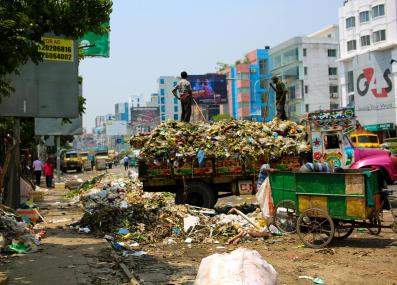Have a question?
Can solar panels be recycled?
Yes, but it's a money-losing enterprise. Boosting recycling rates will take a mix of new solar panel designs, recycling technologies, and policy.
August 20, 2024
Now that solar has been a widespread, mainstream source of energy for a few decades, many solar panels are reaching the end of their lifetimes. Ideally, we’d want these clean energy technologies, which have played a huge role in slowing the pace of climate change, to be just as benign when they’re done harvesting the power of the sun. But that’s not often the case, says Meng Tao, professor at Arizona State University who studies terawatt-scale solar technologies.
It turns out that what makes panels good at surviving outdoors for 20 to 30 years without failing is what makes them hard to recycle. That’s why most are sent to the landfill, Tao says. “Solar panels are designed for performance, reliability, and cost—but seldom for recyclability.”
The current best practice for recycling is to mechanically break down a solar panel into its parts. That way, the aluminum frame that holds a solar panel can be easily recycled, as can electrical cables in the junction box. But recycling the glass that makes up much of the weight of a solar panel is problematic, Tao says.
For one thing, the solar cells are often laminated to the glass and separating them is extremely difficult. If you don’t separate them, the glass is difficult to melt down for reuse: it contains particles of silicon, and silicon has a melting point twice that of glass. “The silicon never melts,” he says. “So you end up with a glass product with these small black particles of silicon inside. Nobody wants that.” Today, the glass is typically downcycled and used in places where its impurities don’t matter—as a construction material, for example.
The problem isn’t that solar recycling is impossible, but that the process has yet to reach a financial break-even point. Tao says it simply costs more to recycle panels—about $20—than the $10 or $12 you can get for the recovered materials. As a result, most home solar is landfilled when its life is over. Panels in large-scale solar farms are more likely to be recycled, Tao says, if only because the company is willing to foot the bill for the recycling process to avoid the bad press of throwing renewable energy products into the garbage.
Tao is researching chemical ways to break solar panel parts back into the elements they’re made of. He also lobbies solar manufacturers to make the panels easier to recycle. For example, he wants them to replace the silver used in small amounts in solar panels with cheaper, more plentiful copper. Today’s solar industry uses far less silver than it used to—and that’s good, since it makes panels cheaper. But it means there’s so little silver left in a panel that it will no longer be worth the time and money it would take to recover it.
Tao and his colleagues are also pushing for panels to eliminate the small amounts of lead used in the solder that connects the solar cells. Lead is toxic in the environment but nearly worthless when recovered from old panels, which is another barrier to recyclers.
Like most recycling issues, solar’s comes down to dollars and cents. Manufacturers aren’t responsible for whether a panel can be recycled, so they aren’t motivated to take on higher costs to build more recyclable panels. The business of solar is still changing fast enough that some companies may not even be around a quarter-century later to take responsibility for their products. Because of public pressure on U.S. and European companies, Tao says, “they are more environmentally conscious than some of the foreign companies.” However, the vast majority of panels—about 90 percent—are made in Asia. And wherever panels are built, government policies that mandate recyclable designs will have a bigger impact than public opinion alone.
Of course, the fossil fuel energy sources that solar is replacing are plenty wasteful. So while renewable energies such as solar and wind create some waste, they also relieve us of gas leaks, oil spills, coal ash and other byproducts of the fossil fuels that are dangerously warming the climate. Besides, recyclability is a problem that can be solved—and the world’s rapid transition to clean energy gives us a rare chance to address our waste problems from the ground up.
Thank you to Carlo Sebok of Rio de Janeiro, Brazil, for the question.
Submit your own question to Ask MIT Climate








